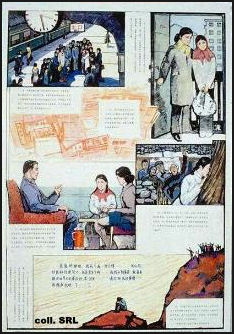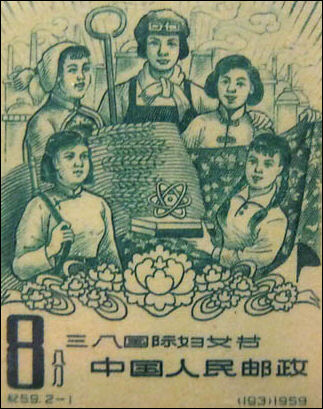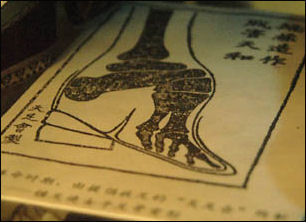WOMEN TRAFFICKING IN CHINA

women trafficking poster
In March 2012, AP reported: Chinese police say they rescued more than 20,000 abducted women and children across China in 2011. A report Sunday from the Ministry of Public Security said police rescued 8,660 abducted children and 15,458 women in 2011 as nearly 3,200 human trafficking gangs were broken up. [Source: Associated Press, March 10, 2012]
Trafficking in women and children is a big problem in China, where traditional preference for male heirs and a strict one-child policy has driven a thriving market in baby boys, who fetch a considerably higher price than girls. Girls and women also are abducted and used as laborers or as brides for unwed sons. No figure was given for the total number of abductions last year. China's vast size and 1.3 billion population means many such cases never get reported.
The government admits this is a small percentage of all the women abducted and sold. Most of the victims are girls and women between 13 and 24. It is not uncommon for foreigners who visit small village to be offered a teen-age bride.
In the old days, wife selling was common and regarded as an ancient custom. It was outlawed by the Communist (Mao ordered the keeping of marriage records partly to discourage the practice). Signs used to be posted in some places that read: "It is Strictly Forbidden to Kidnap and Sell Women and Girls; This Activity Will Be Strictly Prosecuted."
Wife selling returned to China after Mao's death and China's liberalization. Not only Chinese girls are taken. Some girls and young women form North Korea, Myanmar, Laos and Vietnam are kidnaped and taken to China and sold as brides.
A report issued in December 2007 said that women trafficking was on the rise. Much of dirty work is carried out by women trafficking gangs. One Chinese official told U.S. News and World Report, "One gang from Sichuan, for example, takes charge of luring or abducting women — often from their own neighborhoods — away from their villages. They then make contact with a gang in a province like Shandong, which services customers.”
See Separate Articles: SEX RATIO, PREFERENCE FOR BOYS AND MISSING GIRLS IN CHINA factsanddetails.com ; BRIDE SHORTAGE, UNMARRIED MEN AND FOREIGN WOMEN FOR SALE IN CHINA factsanddetails.com ; CHILD ABDUCTION IN CHINA factsanddetails.com ; SALE OF BABIES IN CHINA factsanddetails.com ; PARENTS SEEKING KIDNAPPED CHILDREN factsanddetails.com CHINESE WOMEN factsanddetails.com ; WOMEN IN TRADITIONAL CHINESE SOCIETY factsanddetails.com ; HARD LIFE OF WOMEN IN 19TH CENTURY CHINA factsanddetails.com ; WOMEN UNDER COMMUNISM IN CHINA factsanddetails.com ; MEN IN CHINA factsanddetails.com ; DISCRIMINATION AGAINST WOMEN AND WOMEN'S RIGHTS IN CHINA factsanddetails.com ; DOMESTIC VIOLENCE IN CHINA factsanddetails.com ;
Good Websites and Sources: Women in China Sources fordham.edu/halsall ; Chinese Government Site on Women, All-China Women's Federation (ACWF) Women of China ; Human Trafficking Human Trafficking and Modern Slavery in China gvnet.com ; International Labor Organization ilo.org/public Foot Binding San Francisco Museum sfmuseum.org ; Angelfire angelfire.com ; Wikipedia article Wikipedia
Film: Blind Mountain" (2008) , by director Li Yang, is a slow yet gripping story of a woman who is abducted and sold into labor in a remote village.
Websites and Resources
Good Websites and Sources: All-China Women's Federation (ACWF) website: women.org.cn ; Directory of Sources on Women’s Issues in China /newton.uor.edu ; ; Bibliography /hua.umf.maine.edu ; Library of Congress loc.gov ; 1990s Sources Brooklyn College ; Women in China Sources fordham.edu/halsall ; Chinese Government Site on Women Women of China ; Village Womenwellesley.edu/DavisMuseum ; Marjorie Chan’s Bibliographycohums.ohio-state.edu
Human Trafficking Human Trafficking and Modern Slavery in China gvnet.com ;Human Trafficking.org humantrafficking.org; China Development Brief chinadevelopmentbrief.com ; International Labor Organization ilo.org/public Foot Binding Term Paper on Foot Binding brooklyn.cuny.edu ; San Francisco Museum sfmuseum.org ; NPR Footbinding Story npr.org ; Angelfire angelfire.com ; Wikipedia article Wikipedia
Links in this Website: WOMEN IN CHINA Factsanddetails.com/China ; PROBLEMS FACED BY WOMEN Factsanddetails.com/China ; FOOT BINDING Factsanddetails.com/China ; WORKING WOMEN IN CHINA Factsanddetails.com/China ; FAMILIES, MEN AND YOUNG ADULTS Factsanddetails.com/China ; CHILDREN AND YOUTH IN CHINA Factsanddetails.com/China ; MARRIAGE, LOVE AND DATING IN CHINA Factsanddetails.com/China ; WEDDINGS IN CHINA Factsanddetails.com/China ; CONCUBINES AND DIVORCE IN CHINA Factsanddetails.com/China
Reasons Women Trafficking in China
Women and children are abducted to serve as prostitutes, servants, brides and workers. Many feel that the ultimate cause of women trafficking is the shortage of brides caused by the preference for boys at birth. See Bride Shortage, Population, People.
Many abducted women end up in forced marriages. Sometimes forced marriages are cheaper than consensual ones. Rural wedding and gifts to the in-laws now run around $1,200 while a bride can be bought for a little as $250. If a wife flees the husband usually receives more sympathy than the wife. There is a high demand for brides in Hebei, Guizhou and Guangdong, where there are shortages of women.
The trafficking exists because there is a supply and demand. There is a large pool of victims: thousands of uneducated, inexperienced village girls and women roaming the country in search of work that are easy to take advantage of. Many families that give birth to girls don’t want them and are happy to sell their daughters for the right price. The buyers include famiiles with a son who want a girl to help with the chores and marriage brokers who offer them as brides.
The problem is particularly acute in Guangxi, where the one-child policy is strictly enforced. Most of sellers are rural women who want a son or who already have the legal limit of children and don’t want to pay a fine. The women generally receive no pre-natal care so their pregnancy is unobserved by authorities and sell the grils when they are infants or young girls.
Women Trafficking Victims in China
Some girls are lured away from their homes with promises of high-paying, out-of-town jobs by traders who often take the women's money and identity papers "for safekeeping" so they don't attempt to flee. Others are girls who have left their home towns in search of work and are greeted at the bus stations at their arrival points by men who speak their languages and promise them jobs at factories or homes and then then abduct them and take them to secret hideouts.
Others still are abducted by gangs who drug and rape them before taking them hundreds of miles from their homes to be sold at rural marriage markets. Some are abducted in Guangdong and then taken over 2,000 miles away to Xinjiang Province.
From the hideouts that girls are brought and introduced to buyers. The going price for a bride is between $500 and $1000. Some of the women who have been kidnapped are married women in their 30s with teenage children. According to a woman trafficker, "They all like Sichuan girls. They know how to manage a family.”
Number of Southeast Asian Women Trafficked into China Rising
In December 2011, AFP reported: An increasing number of women from Southeast Asia are being smuggled into China and sold into marriage or forced to work as prostitutes, according to a state media report. "The number of foreign women trafficked to China is definitely rising," the report in the China Daily quoted Chen Shiqu, director of the office for combating human trafficking in the Ministry of Public Security, as saying. [Source: AFP, December 3, 2011]
Without giving figures, he said that many trafficked women come from poor rural areas of Vietnam, Myanmar or Laos and are lured by transnational criminal gangs with promises of good jobs or marriage with rich Chinese men. On arriving in China, the victims are often sold to villagers as brides or forced to become sex workers in underground brothels in coastal or border areas such as Guangdong and Yunnan provinces, he said.
Women are sold for between 20,000 yuan ($3,100) and 50,000 yuan each, with prices varying with appearance and nationality, Jin Yulu, an official at the Ruili border crossing to Myanmar, told the China Daily.Some Southeast Asian women are transported as far as Hebei province in the north, which surrounds Beijing, where police have rescued 206 women since April 2009, the report quoted the provincial public security department as saying.
Sex selection combined with China's population control rules has led to a gender imbalance in the country, with 118.1 boys currently born for every 100 girls against a natural ratio of 105 boys for every 100 girls, according to UN figures.
Women Trafficking Victims in Their New Homes in China
It is estimated that one in ten families in some rural areas in Hebei province have a wife who was sold into marriage. Many houses have barred windows, high fences and chains to keep them from escaping. A 38-year-old farmer in Hebei, who paid $450 for his wife, told Newsweek, "My mother and I kept very tight watch at first. But she settled down quickly and showed no sign of running away. We had a baby boy a year later." [Source: Newsweek, January 22, 1996]
Some women accept their fate, especially those who have given birth to children. An official with the China Women's Federation told U.S. News and World Report, "Chinese women have a strong sense of duty. They think it's shameful to leave once they've committed to a man, however involuntary it is."
The women are often so humiliated by the experience they often go along with the marriage out of fear they will lose face if they return home. Some find the life in their new home is preferable to the poverty back home.
Most victims have no way of escaping or contacting their families. They are watched carefully by relatives and villagers. They villages the end up in have no phones. One victim who was sold for $480 to a farmer told U.S. News and World Report, "There were so many kidnapped women in that village. The girl next store tried to escape once, and the husband and his whole family tied her to a tree and beat her."
Women Trafficking Victims Who Have a Tough Time
There have been reports of women having their Achilles tendons cut to keep them from running away. One woman who was purchased for $450 was shared among three bachelor sons. Another woman had her nose bitten off when she tried to escape.
A Cantonese women was gang raped and was sold five times in less than six months. One woman told U.S. News and World Report she was sold to a peasant for a $360. "He was in his 30s and very ugly, so I refused to go with him. The kidnappers told me if I didn't marry him, they would find me a man in his 60s and it would serve me right." The peasant locked her in his house and his relatives kept an eye on her so she wouldn't escape.
One victim told the New York Times, "I was miserable and homesick but they had taken my money and ID before, when I was abducted, so I really didn't have any choice." One woman who was kidnaped when she 12 and was sold to a 30-year-old peasant told the Independent, "I forgot how to laugh or cry. Each time I did, his family would beat me, They treated me like a slave doing hard labor. Everyone knew about me in the village, but when I protested and ran away, I was caught and beaten. I didn't try again."
Some end up as prostitutes. Their have even been reports of "pyramid prostitutes" schemes in which abducted women and forced or encouraged to recruit their sisters and cousins into prostitution and then take a percentage of their earnings
Efforts to Rescue Women Trafficking Victims
Police rescued 9,000 women and children in 2004 from human traffickers. Special police units and branches of the China Women’s Federation are devoted to rescuing abducted women and educating women and girls about how they can protect themselves.
One man dubbed by "Zorro" by the Chinese press wears a uniform even though he is not officially a policeman. He works independently to retrieve women who have kidnapped and sold as wives. He rescued 100 women between 1992 and 2000.
One victim who was rescued told the New York Times she was initially kept within a house 24 hours a day. As time went on her husband began to trust her and let her out the house. On one outing she managed to call her family. The rescue attempt was thwarted when the husband's family beat up the relatives who tried to save her. She finally won her freedom after her family scraped together $1,250 to hire a detective experienced in women’s kidnapping cases.
Effort to Combat Women Trafficking

Women's Day stamp
In the effort against women trafficking, the government has made highly publicized arrests. In April 2000, police arrested members of a family-led ring that had kidnaped 84 women, 30 of them under 17, and sold them into prostitution in the southern province of Guizhou. .
Men who buy brides can receive prison terms of up to ten years and "traffickers" can be executed. One trafficker tried in Sichuan for selling more than 100 girls and women was executed. More than 30 men who were charged with abducting women were publicly executed in the Shandong province in July, 1992.
According to Chinese police, 143,000 traffickers were caught and prosecuted for abducting and selling women into marriage between 1991 and 1996.
Villagers have more sympathy for men who marry kidnap victims than the kidnap victims themselves. After one man was given a 15 year sentence for buying a wife the judge received hundreds of letters inquiring why a man received such a harsh sentence for "simply buying a wife." A Beijing social worker told Newsweek, "Local people will defend the man who buys a wife. They think if she takes the money and sends it to her parents, he should be able to marry her. Everybody sympathizes with him."
Police are often paid off by kidnappers. One victim told U.S. News and World Report that she approached a peasant for help but the peaseant "said he had no protection"if the kidnappers came after him "because the police were on their side."
The government announced it would begin a five-year plan in 2008 to tackle the problem through programs on the grassroots level and websites that run the names and pictures of victims. The grassroots program will focus on closing down unlicensed job and marriage agencies, which often lure women and children into the sex trade and forced labor.
Women Willingly Seeking Work as Prostitutes in China
An increasing number of young women in Yunnan Province are willingly going to Thailand and Malaysia to work as prostitutes or are being ordered by their families to work in brothels in these countries because the money is good. Girls from the Dai minority are particularly sought after in Thailand because they are regarded as beautiful and their language is similar to Thai.

foot binding, see separate article
One 20-year-old woman in the Mekong River village of Langle told the New York Times, “If you can’t go to Thailand and you are a young woman here, what can you do? You plant and you harvest. But in Thailand and Malaysia I heard it was pretty easy to earn money so I went....All the girls would like to go, but some have to take care of their parents.”
The girls work in bars and most of the money they take in tricks goes to their pimp or brothel owner. The money they earn comes from “tips” by customers. Many make their way across the border hidden in the baggage compartment of buses and hope to get lucky and meet and marry an overseas Chinese or at least bring enough money back for a better life for themselves and their families.
Many are unable to save much even after a couple of years. Some do quite well and this is often reflected by the nice homes — with satellite television, air conditioning, generators and tile designs — owned by their parents. Some families with several daughters live in chateau-like homes with chandeliers, leather-covered sofas, golden Buddhist altars and fancy home entertainment centers. Dai boys often don’t like the set up because the girls who return from Malaysia and Thailand come back snobby and don’t want to have anything to do with them.
Image Sources: Posters: Landsberger Posters http://www.iisg.nl/~landsberger/ ; Asia Obscura
Text Sources: New York Times, Washington Post, Los Angeles Times, Times of London, Lonely Planet Guides, Library of Congress, Chinese government, Compton’s Encyclopedia, The Guardian, National Geographic, Smithsonian magazine, The New Yorker, Time, Newsweek, Reuters, AP, AFP, Wall Street Journal, The Atlantic Monthly, The Economist, Foreign Policy, Wikipedia, BBC, CNN, and various books, websites and other publications.
Last updated July 2015
